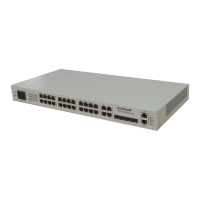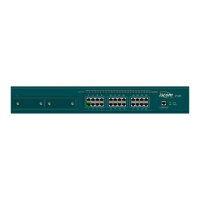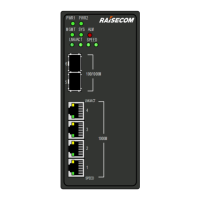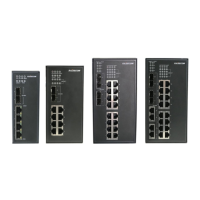
Do you have a question about the Raisecom ISCOM2600G-HI (A) Series and is the answer not in the manual?
| Switching Capacity | 56 Gbps |
|---|---|
| Forwarding Rate | 41.7 Mpps |
| MAC Address Table | 8K |
| Ports | 24x 10/100/1000BASE-T |
| Uplink Ports | 4x 1000BASE-X SFP |
| VLAN | 4K |
| Power Supply | AC: 100~240V, 50/60Hz |
| Operating Temperature | 0°C~45°C |
| Storage Temperature | -40°C to 70°C |
| Operating Humidity | 10%~90% (non-condensing) |
Describes features supported by the ISCOM2600G-HI series switch and related configurations.
Lists the product versions related to this document.
Explains symbols, general conventions, and command conventions used in the document.
Introduces the Command Line Interface (CLI) as a medium to configure, monitor, and manage the switch.
Details methods for connecting to and accessing the switch, including Console, Telnet, and SSH modes.
Discusses managing system files, including BootROM, system boot files, and configuration files.
Explains how to load and upgrade system software through BootROM or CLI.
Explains how the switch automatically obtains new versions and configurations via DHCP.
Covers configuring system time, time zone, DST, NTP, and SNTP for accurate time synchronization.
Details managing Ethernet interfaces, including attributes, auto-negotiation, and flow control.
Covers basic system information configuration, such as device name and language.
Explains how to schedule tasks for periodic or timed execution of commands.
Discusses configuring the watchdog timer to prevent system program endless loops and improve stability.
Explains how to configure login banners to display messages during login or exit.
Covers MAC address table functionality, forwarding modes, classification, and configuration.
Covers Virtual Local Area Network (VLAN) concepts, partitions, interface modes, and configuration.
Covers Private VLAN (PVLAN) concepts, types, modes, and configurations for Layer 2 isolation.
Covers QinQ (Stacked VLAN) technology, including basic and selective configurations.
Covers VLAN mapping concepts, principles, and configuration for replacing private VLAN Tags.
Covers Spanning Tree Protocol (STP) and Rapid Spanning Tree Protocol (RSTP) for loop prevention.
Covers Multiple Spanning Tree Protocol (MSTP) concepts, regions, instances, and configurations.
Covers Multiple Spanning Tree Protocol (MRSTP) for bridged LANs, including its introduction and configuration.
Covers loop detection mechanisms, loop types, principles, and configuration for network stability.
Covers interface protection for isolating Layer 2/Layer 3 data and enhancing security.
Covers port mirroring for monitoring network traffic by copying packets to a monitor port.
Covers Layer 2 Control Protocol (L2CP) processing modes and profile configuration.
Covers Voice VLAN features for prioritizing voice traffic and improving call quality.
Covers Generic Attribute Registration Protocol (GARP), its messages, timers, and GVRP application.
Introduces ISF as a virtualization technology that connects multiple devices into one.
Covers basic ISF concepts including operating modes, roles, member IDs, ISF interfaces, merge, and split.
Outlines the steps for establishing an ISF environment, including planning and physical connection.
Discusses ISF configuration modes: preconfiguration and non-preconfiguration.
Covers preconfiguring ISF parameters like unit ID, member priority, and interface in standalone mode.
Discusses configurations specific to the ISF mode, including domain ID, interfaces, and member ID.
Lists commands to check ISF configurations, including general info, topology, packets, and MAD status.
Provides configuration examples for ISF scenarios, including BFD MAD and mode switching.
Covers Ethernet Ring Protection Switching (ERPS) based on G.8032 standard for fault detection and recovery.
Covers Ethernet Linear Protection Switching (ELPS) based on G.8031 for protecting Ethernet links.
Covers fundamental IP concepts like interfaces, Layer 3 configuration, and double-tagged packets.
Covers Loopback interfaces, their types, and configuration for management and routing identification.
Covers Address Resolution Protocol (ARP), its introduction, modes, static and dynamic entries, and proxy ARP.
Covers Neighbor Discovery Protocol (NDP) for IPv6, including its introduction and configuration.
Covers static routes, default routes, and their configurations for network connectivity.
Covers Routing Information Protocol (RIP), its definition, principles, versions, and configurations.
Covers Open Shortest Path First (OSPF) protocol for IPv4, including its functions, types, and configurations.
Covers DHCP client functionality, introduction, preparation, and configuration for obtaining IP addresses.
Covers the zero-configuration feature for automatic IP address assignment and configuration download.
Covers DHCP Snooping as a security feature to ensure clients obtain IPs from legal DHCP servers.
Covers DHCP options used for dynamic network configuration and client identification.
Covers DHCP Server functionality for assigning IP addresses and network configurations to clients.
Covers DHCP Relay function to provide service between DHCP clients and servers in different segments.
Introduces Quality of Service (QoS) and its importance in managing network applications and traffic.
Covers configuring packet priorities, including trust modes and mapping from CoS/DSCP to local priority.
Discusses queue scheduling algorithms like SP, WRR, DRR, and their role in managing network congestion.
Covers congestion avoidance mechanisms like Random Early Detection (RED) to manage network traffic.
Covers classifying packets and applying traffic policies for differentiated services.
Covers rate limiting based on interface, VLAN, or traffic policy to control network traffic.
Covers bandwidth guarantee, hierarchical bandwidth guarantee, and color-aware marking.
Provides configuration examples for QoS features like congestion management and rate limiting.
Introduces multicast, its comparison with unicast/broadcast, advantages, and applications.
Covers basic IGMP functions and Layer 2 multicast features like IGMP Snooping and MVR.
Covers IGMP Snooping, a mechanism for managing and controlling multicast groups on Layer 2 devices.
Covers IGMP Querier, a proxy mechanism for managing multicast group membership.
Covers IGMP Multicast VLAN Registration (MVR) for managing multicast groups across VLANs.
Covers IGMP filtering profiles and limiting the maximum number of multicast groups allowed.
Covers Multicast VLAN copy, a feature for optimizing multicast data transmission across VLANs.
Covers Multicast Listener Discovery (MLD) protocol for IPv6 multicast management.
Introduces Operation, Administration, and Maintenance (OAM) and its importance for Ethernet technology.
Covers Ethernet First Mile (EFM) OAM technology for link connectivity detection and fault monitoring.
Covers Connectivity Fault Management (CFM) for end-to-end fault detection and maintenance.
Covers Service Level Agreement (SLA) for network performance testing and statistics.
Covers Bidirectional Forwarding Detection (BFD) for rapid fault detection and communication path management.
Covers Access Control Lists (ACLs) for filtering packets based on various criteria.
Covers Port Security MAC feature to limit and distinguish users accessing the network based on MAC addresses.
Covers Dynamic ARP Inspection (DAI) for preventing ARP spoofing attacks and securing the network.
Covers RADIUS for centralized authentication, authorization, and accounting of network access.
Covers TACACS+ protocol for network access authentication, authorization, and accounting.
Covers storm control mechanisms to prevent broadcast storms caused by excessive traffic.
Covers 802.1x authentication for network access control, including its procedure and timers.
Covers IP Source Guard for preventing IP source spoofing and ensuring IP address validity.
Covers PPPoE+ for processing authentication packets and adding user identification for network security.
Covers CPU protection mechanisms like CPU CAR to limit packet rates and prevent CPU overload.
Covers measures to prevent ARP attacks, including ARP configuration and rate limiting.
Covers link aggregation technologies like manual, LACP, and mLACP for increased bandwidth and reliability.
Covers interface backup for dual uplink networking, providing redundancy and fast switching.
Covers link-state tracking for interface linkage and extending link backup range.
Covers UniDirectional Link Detection (UDLD) for monitoring physical connections and detecting faults.
Covers Multi-Chassis Link Aggregation Control Protocol (mLACP) for selecting paths for Dual Home Devices.
Covers Simple Network Management Protocol (SNMP) for managing network devices and monitoring status.
Covers Remote Network Monitoring (RMON) for network data monitoring and statistics collection.
Covers Link Layer Discovery Protocol (LLDP) for discovering network topology and device information.
Covers Optical module Digital Diagnostics Monitoring (DDM) for diagnosing SFP performance parameters.
Covers system logging for recording system information, debugging, and fault diagnosis.
Covers alarm management, including classification, output modes, and related concepts.
Covers monitoring hardware environment aspects like temperature, power supply, and fans.
Covers CPU monitoring for tracking utilization rate, task status, and detecting potential CPU overload.
Covers cable diagnosis functionality to detect lines, locate faults, and clear issues.
Covers memory monitoring for real-time utilization tracking and threshold alarms.
Covers the Ping utility for testing network connectivity and IP address reachability.
Covers the Traceroute utility for testing network nodes and analyzing network faults.
Covers performance statistics gathering for interface or service flow analysis.
Lists and defines terms, acronyms, and abbreviations used in the document.
Lists and defines acronyms and abbreviations used throughout the document.










